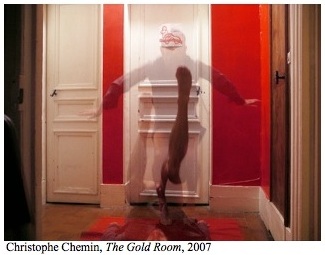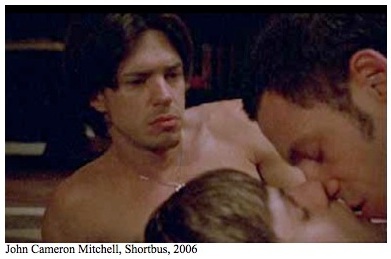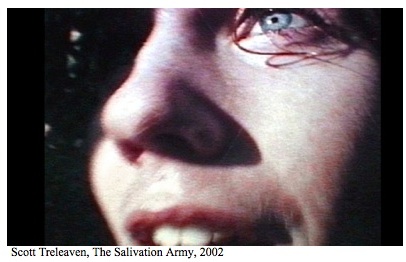At a glance: "Queer Cinema: Today and Yesterday," is a series of films spanning 1953-2010 selected by artist AA Bronson from the collection of the Museum of Modern Art. Screenings will take place at the Museum every day between March 11-17, 2011. MoMA is located in midtown Manhattan, New York City, at 11 West Fifty-third Street, between Fifth and Sixth avenues. A list of the films and their time of screening is featured in the highlighted box below.
It remains arguable whether queerness has evolved to the brink of true acceptance in developed, democratic nations. Queer culture is another story altogether, with only the spiritually blind incapable of admitting that queer art, cinema and literature saturate the rising tide of art and entertainment today. Sociologists have to do the long hard work of collecting and compiling statistics, then charting them out in demographic bell curves to fully appreciate the extent of society's queer assimilation. The rest of us have the altogether more pleasurable evidence of cinema at our disposal -- always the most semiotically rich mine of social and moral evolution--in this case the queervolution of underground film from 1950 to the present.
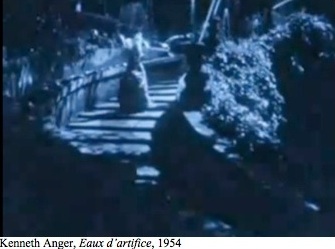
The Museum of Modern Art series, "Queer Cinema from the Collection: Today and Yesterday" is a trove of roughly-cut gems snatched in AA Bronson's raid on MoMA's vault of underground film (with inside help from MoMA Associate Curator of film, Joshua Siegel). More a connoisseur selection than a comprehensive history of the queer underground, the series reflects the vision of North America's most esteemed queer artist-shaman-patriarch, AA Bronson, the only member of the Canadian artist collective General Idea to survive the onslaught of the Age of Aids. It's Bronson's personal and poignant remembrance of the films that informed Canada's most renowned and significant contribution to queer culture. It's also Bronson's cleverly designed play off the museum's collection, one perfectly in keeping with the best of the ironic appropriations of General Idea, and in this sense the series is itself a work of art by Bronson.
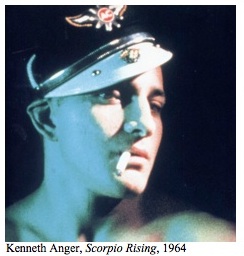
General Idea, of course, is that sweetly pungent trio of artists comprised of Bronson, Jorge Zontal and Felix Partz. Before the premature deaths of Zontal and Partz in 1994, the trio had ensconced themselves with international cult status chiefly for what became the premiere icon of the Age of AIDS -- their mimicry of Robert Indiana's 1960's LOVE paintings unto which they supplanted, in Indiana style and a variety of colors, the word AIDS. Even before their acerbic hijacking of Indiana's art became their signature in a seemingly endless edition of prints, wallpaper, stamps, and sculpture, the trio became renown for an iconography of camp intellectualism and activism that has as much historic currency today as it was pungent social commentary in its day. The Miss General Idea Pageant, File Magazine covers, queer poodles and endangered baby seals analogies, giant AZT capsule installations and run-on wall reliefs, and chromatic video test patterns all caustically and ironically index some aspect of the fin de millennium lifestyles of queer men and their mythically-enhanced aesthetic proclivity for post-minimalist design and wit, while effecting their own naked, if artworldly de rigueur, "deconstruction."

Today Bronson lives in New York with his husband, the architect Mark Jan Krayenhoff Van de Leur. Despite his Candian citizenship, Bronson was named last month a chevalier of the Ordre des arts et lettres, the highest honor in France for his contribution to visual art. As the award indicates, Bronson today flourishes after surviving a consummately devastating period that seemingly left him bereft of direction after the deaths of his friends and collaborators. His healing manifested in a visual requiem to Zontal and Partz, a photographic elegy depicting Zontal's last days and Partz laid out at his wake, a series that is every bit as stirring to us today as the ancient Egyptian artistic preparation for the afterlife must have seemed to the pharaohs. Upon finishing the series, Bronson reemerged with a brand of post millennial art that, though altogether more earnest than the art of his General Idea incarnation, is just as transgressive for residing at the cusp between reason and spiritualism. Bronson's present production is an amalgam of shamanistic enterprise, healing sculpture, imagery, and spiritual-erotic massage-performance art that has been unofficially branded as the gay male recourse to living with the detonator of HIV still ticking in the mind despite the apparent (if dubious) constraint of the retrovirus in the absence of a certain cure. The names of his recent projects alone speak of his new orientation: case in point, Invocation of the Queer Spirits, which he presented in New Orleans, Winnipeg, and New York. And then there is his role as the artistic director of the Institute for Art, Religion and Social Justice at the Union Theological Seminary.
Bronson's biography is as pertinent to the gaps in the MoMA screenings as to the inclusions. Artists, after all, make the worst art historians and curators, what with the self-interest of their own contributions front and center in their perspective on art and history. All of this is entirely within the artist's rite and the artist's right, and I for one am grateful that it is. Without the artist's penumbral blindpot, we critics and commentators on visual art would have little space allotted to us in the art world. For example, it's up to us to point out that a robustly representative history of underground cinema would overflow with lesbian, transexual and international contributions. As it stands, it's the queer male experience that defines AA Bronson and General Idea, and hence the MoMA selection. Bronson begins with two definitive imagistic queer films that had informed the collaborative art of General Idea. By imagistic, I mean film that supplants narrative with retinal values, or when narrational, doesn't allow the narrative to dominate the formal vision of the artist. Of the groundbreaking generation of outrageous queer imagists--Jean Genet, Kenneth Anger, Jack Smith, Andy Warhol and John Waters--only Anger and Warhol are represented, though Bronson cites Smith as essential.

"The story begins in the mid-sixties," he writes, "when I screened a double bill of Kenneth Anger's Scorpio Rising and Jack Smith's Flaming Creatures at the School of Architecture where I was studying. Both films had been banned, and that was reason enough for me to present them, in a long evening that eventually became rather rowdy, ending in some sort of happening, with wet noodles and nudity. I include Anger's Eaux d'Artifice for equally personal reasons: in 1970 a friend who was working at a film distribution house stole a copy of this soulful work, so moved was she by its beauty. We played it again and again in our rather cold and barren General Idea loft, stunned into (stoned) silence by its cold blue luminosity."
The Warhol film Bronson selects is Harlot, made in 1964. "In 1966 I attended the Trips Festival in Vancouver, a psychedelic extravaganza of several days that included, most memorably for me, a reading by poet Michael McClure broadcast over a grid of some 40 overhead speakers, orchestrated so that his animal noises seemed to move in waves around the space, and a "retrospective" of films by Andy Warhol, all projected simultaneously around the outer walls of the Pacific National Exhibition Garden Auditorium, of which only Harlot had a sound track." So goes the biography that dictates the artists represented.

In choosing from the second wave of the queer underground -- a generation that grew up in the 1980s and 1990s to supplant outrageous spectacle with the ironic and politicized outrage of a plague-ridden generation--Bronson neglects Todd Haynes, Tom Kalin, and David Wojnarowic, while including only Derek Jarman and General Idea. Jarman at first seems to be included only because Bronson met the filmmaker at the premiere of Jarman's film Jubilee. But rather than screen Jubilee as would be expected, the film Bronson has selected is Jarman's last, the exceedingly personal yet minimalist Blue, which is comprised of a single shot of a blue field representing the last of Jarman's vision as he goes blind from AIDS and has only his hearing--our soundtrack--left to tell him--and us--what transpires in the world around him.

Even without the reference to the filmmaker's death by AIDS tying Jarman to General Idea, the selection of Blue makes sense after watching General Idea's 1984 film XXX Blue (see photo), the third part of Shut the Fuck Up. In watching the 1961 Yves Kline painting film segment included in XXX Blue, along with Kenneth Anger's Eaux d'Artifice and Derek Jarman's Blue, we understand that in Bronson's selections, he's not only riffing off the same shade of blue that Klein made his signature and which colors Anger's Eaux d'Artifice, he's also tying in Jarman's most personal and last cinematic statement to the necklace of films he regards to be central to the queervolution of underground cinema. (And need I point out the obvious pun off blue movies being made?)
Similarly, in Warhol's Harlot, we see one of the many prototypes for The 1971 Miss General Idea Pageant, a performance held at The Art Gallery of Ontario on October 1, 1971. It's a performance that has since been immortalized by publications around the world that reproduce the photo of Miss General Idea originally printed in a programme handed out to the audience. For just as much of General Idea's practice bore weighty relationships to prior art, the selection of recent films screened at MoMA has cleverly been selected to echo General Idea's oeuvre, as well as Bronson's solo work produced since 2000. Mimicry, echoing, riffing, appropriation, irony: all are the general idea behind not just General Idea, but of art in general. It's the thread running through the most knowing art that makes it appear immortal ... or at least ubiquitously connected and relevant.

It's too early to tell if the echos of General Idea apparent in the films made after 2000 will have lasting value or influence. Either way, we're fortunate that MoMA has collected this diverse generation of artists so early in their careers. Such diversity can be accounted for because this is a generation far less scarred by prejudice or conditioned by essentialist ideology and identification. Nor has it been burdened with the need to defend the queer aesthetic frontier, as queerness comes dripping off them as naturally as sweat. Coming of age in a climate of plague has constrained the libidos of some, while contorting the desire of others into mannerist fetishism that seems at times to be derivative of what the artists know through magazines and historic documentaries rather than any urgent, inner compulsion or experience. There are the customary scenes in which internal tensions and desires build, but no longer with the sense of taboo or guilt hanging over the characters. In comparison with the generations of queers from the past, it appears this generation both enjoys and suffers from a prolonged adolescence marked by naiveté, awkward relations and experiments, thwarted desires, and much obsessing over trivialities in the name of queerness, crossdressing and attempts at public or group sex for which the participants aren't always well equipped. The most effecting work for this viewer are the artists who appear to follow Bronson's lead in practicing art as a vaguely shamanistic ritual, if not something akin to a healing spirituality, or at the least, some sleight of hand that mesmerizes audiences with the kind of tropes that ensure cinema will regain some measure of the sensuality and artifice audiences crave, at least for the next decade. Many of these films have had limited exposure in New York, usually in festivals and small gallery exhibitions. Artists such as Chemin and Treleaven are still making impressions, while others, like Terence Koh (Whitney Museum, 2010 Grammy Awards) and John Cameron Mitchell (Hedwig and the Angry Inch, Rabbit Hole), are well established stars, respectively, of the artworld and independent film. All the artists are well worth getting to know better.
Since the selection of the films is so clearly personal to Bronson in the profoundest sense of relating to his life, faith and art, from hereon it's he and the artists themselves who should speak for the films.
Friday, March 11, 2011, 6:30 p.m. Theater 2, T2
New and Younger TalentsDolly
2009. Canada. Directed by Keith Murray. Keith Murray's transgendered vision of the self is a transcendent ode to love.4'26"
2007. USA. Directed by Terence Koh. The artist, face hidden by a long black wig, and naked except for a pair of very high black patent-leather high-heeled boots, dances to music on an iPod that only he can hear. The title refers to John Cage's infamous composition of the same name, consisting of 4 minutes 26 seconds of silence.The Gold Room
2007. Germany. Directed by Christophe Chemin. I first came across Christophe Chemin on MySpace, when he asked to become my friend. He is a sexy lad with a magnetic, almost mystical force, which hit me from the far side of the Atlantic. The Gold Room is imbued with shamanic energy, fringed with the erotic. He was an easy choice for this project.
Public Inconvenience
2004. Colombia. Directed by Fernando Arias. Public Inconvenience was shot in a public toilet in London using a small surveillance camera hidden on the artist's body.Mansfield 1962
2006. USA. Directed by William E. Jones. In Summer 1962 the Mansfield, Ohio, police department clandestinely photographed men having sex in a public restroom, convicting over 30. Later, the police produced an instructional film for internal use, showing how to set up a sting operation to arrest "sex deviants." Jones re-edits this footage into a haunting, silent condensation of the original.Now It's in My Eyes
2007. Germany. Directed by Christophe Chemin.One Night at Andre's
2007. Canada. Directed by Steve Reinke. Steve Reinke, master of the one-minute video, came to my rescue when I complained about the lack of explicit sex in artists' videos.Inside the Pavilion of Virginia Puff Paint
2004. Canada. Directed by Jeremy Laing, Will Munro. "Peer through the glory-hole into the Pavilion of Virginia Puff Paint... Watch as this insatiably versatile vision of hand-stitched polysexuality tickles multiple lacy orifices... Freshly plowed by a rhinestone stiletto and dripping pearled entrails... Virginia, having exhausted the possibilities for penetration, collapses in a shower of sequins."Anthology of American Folk Song
2004. Canada. Directed by Steve Reinke. From Reinke's own website, myrectumisnotagrave.com, comes this description: "Named after Harry Smith's seminal Anthology of American Folk Music, Anthology of Anthology Of American Folk Song...is the first in a series called Final Thoughts, an archive of found and original material collected by Reinke. Anthology is permeated by a sense of menace, standing as an oblique, disparate catalogue of small humiliations, traumas and strange, absurd, occasionally beautiful images and songs that queer the mythologies of a culture in crisis." This rarely seen video is probably Reinke's most complex and beautiful/perverse work.Saturday, March 12, 2011, 1:30 p.m., Theater 2, T2
Eaux d'artifice
1953. USA. Directed by Kenneth Anger. In 1970 a friend who was working at a film distribution house stole a copy of this soulful work, so moved was she by its beauty. We played it again and again in our rather cold and barren General Idea loft, stunned into (stoned) silence by its cold blue luminosity. Our loft was situated on the third floor of an old office building in the heart of the financial district of Toronto, and I remember that blue light flickering through the night, reflecting off the sea of desks that presented itself so mesmerizingly in the building facing ours. 12 min.Blue
1993. Great Britain. Written and directed by Derek Jarman. With the voices of Jarman, Tilda Swinton, Nigel Terry, John Quentin. I first met Derek Jarman when he came to a General Idea exhibition opening in London in 1978. He invited us to come to the premiere of Jubilee the following night and generously picked us up in his car. His boyfriend at the time felt me up surreptitiously in the back of the car while Derek chattered excitedly to us from the front. After the premiere, a group of us feasted on roast potatoes in the warmth of a plastic-enclosed tent in his otherwise frigid loft. I have chosen Blue rather than that earlier film because my life... 79 min.Sunday, March 13, 2011, 2:30 p.m., Theater 1, T1
Shortbus
2006. USA. Written and directed by John Cameron Mitchell. With Sook-Yin Lee, Paul Dawon, Lindsay Beamish, Jay Brannan, PJ DeBoy, Raphael Barker, and Justin Bond. I found this brief description online: "A group of New Yorkers caught up in their romantic-sexual milieu converge at an underground salon infamous for its blend of art, music, politics, and carnality." The title refers to a weekly social/artistic/sexual salon in Brooklyn called "Shortbus," hosted by Justin Bond, the inimitable drag performance artist, who plays himself. Although I have never attended a salon of quite this type, I recognized it immediately as my natural home. This is the first and last movie, especially of the variety seen in mainstream cinemas, to speak directly to me, depicting any number of people who might have been my friends. One of the radical aspects of this film, apart from its very direct depiction of sex, is its vision of intense social community. 101 min.
Sunday, March 13, 2011, 5:00 p.m., Theater 2, T2
Scorpio Rising
1964. USA. Directed by Kenneth Anger. In 1965 I screened a double bill of Kenneth Anger's Scorpio Rising and Jack Smith's Flaming Creatures at the School of Architecture in Winnipeg, where I was studying. Both films had been banned, and that was reason enough for me to present them, in a long evening that eventually became rather rowdy, ending in some sort of happening, with wet noodles and nudity. Scorpio Rising was the first message I received from the world of culture that who and what I felt myself to be was entirely OK, that there is lots of room for diversity in this world. 28 min.Harlot
1964. USA. Directed by Andy Warhol. Screenplay by Ronald Tavel. With Gerard Malanga, Mario Montez, Philip Fagan, Carol Koshinskie. Offscreen voices: Tavel, Billy Name, Harry Fainlight. In 1966 I attended the Trips Festival in Vancouver, a psychedelic extravaganza of several days that included, most memorably for me, a reading by poet Michael McClure broadcast over a grid of some 40 overhead speakers, orchestrated so that his animal noises seemed to move in waves around the space, and a "retrospective" of films by Andy Warhol, all projected simultaneously around the outer walls of the Pacific National Exhibition Garden Auditorium, of which only Harlot had a sound track. 67 min.Wednesday, March 16, 2011, 6:30 p.m., Theater 2, T2
General Idea: Films and Videos, 1971-84
Jorge, Felix, and I lived and worked together under the name of "General Idea" from 1969 through 1994, when Felix and Jorge both died, bringing our experiment in collaboration to an end. Looking back over our life together, I realize that much of our work was a kind of self-portraiture, a picturing of ourselves in a semi-fictitious narrative as whom we felt we really were. Especially in our film and video work, this queer vision is central.God Is My Gigolo
1969/70. Canada. Directed by AA Bronson, Felix Partz, Jorge Zontal. General Idea's first collaborative project is this 16mm film, here beautifully restored, but missing its sound track. General Idea's extended family make appearances in this epic poem of a young woman's voyage to sexual fulfillment. Key influences were the Kuchar Brothers and the French New Wave (La Nouvelle Vague). 30 min.Double Mirror Video
1971. Canada. Directed by AA Bronson, Felix Partz, Jorge Zontal. A conceptual self-portrait using two mirrors and a Sony portapak. 5 min.Pilot
1977. Canada. Directed by AA Bronson, Felix Partz, Jorge Zontal. Produced for television broadcast by OECA TV, Toronto. From 1971 on, all of General Idea's videos were conceptualized as television broadcasts. Pilot is the first actually made for television though, and became a late night cult hit on Canadian educational television in the late seventies. It is conceived as a "pilot" for a non-existent series, and acts as an introduction to General Idea. Much of it was shot with super-8 film, only the head-and-shoulder segments being recorded in the television studio. 29 min.Test Tube
1979. Canada. Directed by AA Bronson, Felix Partz, Jorge Zontal. Produced for television broadcast by de Appel, Amsterdam. In 1979, we were invited to Amsterdam by de Appel to produce the first of a series of artists' made-for-television videos. The Stedelijk Museum gave us a small studio, as well as our first museum exhibition. We lived there for three months, meeting the local artists, many of whom (Marina Abramović, for example) made cameo appearances in the finished video. Test Tube used the language of television, including the visual formats of talk show, soap opera and so on, but also the chromatic language of television, to construct a portrait of the artist. Portending the future, Test Tube presented the artist in a context of the marketplace: dealers, sales, museum shows, and Documenta. Dutch television refused to air the completed work, because it "looks too much like television," but it went on to be broadcast in Spain, Switzerland, Canada, and the U.S. 28 min.Loco
1982. Canada. Directed by AA Bronson, Felix Partz, Jorge Zontal. Produced for CBC Television by Mendel Art Gallery, Saskatoon. A more ethereal view of the artist as "lunatic poodles", receiving their inspiration from the night. Black and white views are excerpted from our first film God Is My Gigolo. 10 min.Shut the Fuck Up
1984. Canada. Directed by AA Bronson, Felix Partz, Jorge Zontal. Produced for television broadcast by Talking Back to the Media, Amsterdam. Conceived as a sequel to Test Tube, and once again produced fro Dutch television, Shut the Fuck Up again presents the three artists of General Idea on the artist's relation to the media. We appropriated edited versions of popular media as samples from which to draw our subject matter: a B movie, a television show, and a made-for-television music spectacular. In the end, our message to the media is "Shut the Fuck Up"--or is it? 14 min.Thursday, March 17, 2011, 6:45 p.m., Theater 2, T2
Works by Scott Treleaven
From Scott Treleaven: "From 1996 to 1999 I published a queer zine called This Is the Salivation Army. The film The Salivation Army (2002) was an attempt to make a documentary about my adventures in underground publishing that respected not only the actual events, but people's perceptions of those events which proved to be just as consequential. Everything in the film is "real" so to speak, but the reality is delivered alongside a mythology that eventually eclipses it. Lustre (2005) was based on a short story that never made it into the zine, an allegory about how people with shared affinities find one another, and a literal interpretation of the punk aphorism "the flowers in the dustbin." In a similar vein to The Salivation Army, Silver (2006) and Gold (2006) started off as an idea to make film portraits of friends who'd had a mentoring influence on me, but I eschewed more straightforward biographical details and tried to draw on the kind of iconography and aura I associated with them instead. The films came together around things like AA Bronson's use of mirrors in his artwork, his interest in scrying and fortune-telling, his John Dee-like countenance; [Lady] Jaye and Genesis [P-Orridge]'s fascination with the pandrogyne, their physical dynamic and relationship, their surgeries, and an amazing staircase in their Ridgewood apartment building that could visually be made to (un)wind like an enormous DNA strand. The films also emerged as meditations on the Hierophant and Art cards of the tarot, respectively. Also embedded in the portraits are mini-homages to Derek Jarman, Maya Deren, Jack Smith, and others."Silver. 2006. Canada. With AA Bronson. Soundtrack by Andrew Zealley Gold. 2006. Canada. With Genesis P-Orridge, Lady Jaye Breyer P-Orridge. Soundtrack by Andrew ZealleyLustre. 2005. Canada. With Massimo & Pierce of Black Sun Productions. Soundtrack by Andrew Zealley The Salivation Army. 2002. Canada. With Kevin Drew, Will Munro. Soundtrack by KC Accidental, Psychic TV.
Read other posts by G. Roger Denson on Huffington Post in the archive.

